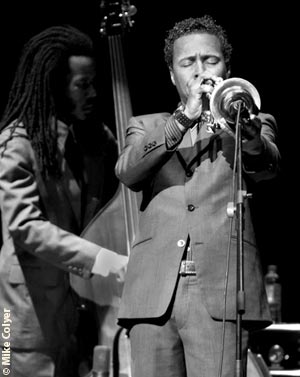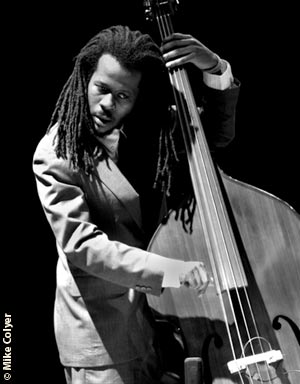
|
| The Roy Hargrove Quintet – With special guest The Bad Plus |
| February 10, 2007 • Massey Hall • Toronto |
|
|
Burnin’ Up The House
by Paul J. Youngman with photos by Mike Colyer |
| As if it wasn’t bad enough to have The Bad Plus take to the stage in storm trooper form and tear up some of their material (five songs), as well as legendary Canadian hard rock band Rush’s material — with a drum solo by David King, that was, as Ethan Iverson put it, “If anybody sees Neil Peart, tell him The Bad Plus copied his drum solo, beat for beat.” Less the 10 or 20 extraneous drums in Peart’s arsenal, yet with twice the energy and enthusiasm, this was a true statement. Reid Anderson, mixing pizzicato vocal lines on his bass with passionate lyricism, adding intricacy non-reminiscent of Geddy Lee, was an accompanist par excellence.
No, as if that wasn’t bad enough, we were forced to sit through two hours of one of the most amazing jazz quintets on the planet, as they burned through some of Roy Hargrove’s material from his 2006 CD Nothing Serious, and one song from the CD Habana, a rip-roaring samba flavoured tune. The most amazing quintet to pass through Toronto so far this year, was made up of Roy Hargrove (trumpet), Gerald Clayton (piano), Joseph Sanders (bass), Justin Robinson (alto saxophone) and Montez Coleman (drums).
|
|
The Roy Hargrove Quintet, looking like they stepped from the pages of an Armani catalogue, or were en route to the Grammys, raced on stage. Hargrove made a minor adjustment to the microphone, he surveyed the scene at legendary Massey Hall, the audience with a collective sigh of anxiousness or sensitivity to the aura of this trumpeter extraordinaire, expecting a voice, were treated instead to the strongest statement possible. Hargrove would simply and directly place trumpet to lips, and blow the sweetest sounding muted tone, a tone that pierced your soul — think of all the great trumpeters, Brown, Morgan, Navarro, combine and refine, and you have Hargrove’s delicious tone.
The band was playing at a rapid tempo, a side effect from following The Bad Plus who played non-stop at a frenetic pace, an animated jazz delight. Upon completion of Hargrove’s opening statement to the audience, he would depart to make room for an extended break by altoist Justin Robinson, playing an inspired break that took him through every possible combination of notes his horn had available. Robinson’s final statement would open the tune for Gerald Clayton on piano, reminding me of a stride piano player in the Art Tatum style of waterfall runs and all.
We were treated to Hargrove on open trumpet for most of the show; on one tune he played flugelhorn. Hargrove on open trumpet is dazzling, he creates breaks that are exciting, his tone is wonderful and he utilizes dynamics to great effect. He will take his solos to a climax by building with the use of well placed accents, beautiful sweet sounding runs, augmented by blue notes, interspersed with off sounding notes, attention catchers, followed up with a fluttering note or group of notes in the higher register. He will sustain these fluttering notes without interruption through sixteen or more bars, thus creating instant whoops of delight and abrupt applause from the audience. Not quite finished, he will continue on with some bold statement, something to do with the state of jazz no doubt, swaying from side to side, eyes closed, before departing to stage right with a slight nod of thanks for the applause he has once more deservedly created.
|
|

Roy Hargrove |
|

Joseph Sanders |
|
|
| There were many highlight moments, from astounding bass solos to incredible drum solos. We sampled the future of jazz through piano virtuosity that created instantaneous applause midway through an inspirational solo. There was no end of alto saxophone delight. We were treated to beautiful songs from the Hargrove song book, none of which he made mention of. A man of few words, he is a musician who says all that really needs to be said with his axe. Mr. Hargrove’s axe is honed to a very fine edge.
The band would honour us with an encore, very little effort was expended by the crowd, the band returned rapidly and played their hearts out for another quarter of an hour. Hargrove announced the names of the members of his quintet once more, he thanked the audience, expressing his love, in words this time, “I love you.” he said. The band would form a line at the front of the stage and take a deep and long bow, while the audience cheered and offered a second standing ovation. As the band marched off stage, Mr. Hargrove would stop and turn, he seemed to be imprinting the image of a standing ovation at Massey Hall, all this appreciation, he wanted just one last look. Could he be thinking, is jazz worth it, is jazz worth all this love?
|
|
|
|
|
|
|



